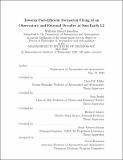Towards fuel-efficient formation flying of an observatory and external occulter at Sun-Earth L2
Author(s)
Sanchez, William D.(William David)
Download1193319520-MIT.pdf (33.76Mb)
Other Contributors
Massachusetts Institute of Technology. Department of Aeronautics and Astronautics.
Advisor
David W. Miller, Sara Seager, Richard Linares and Oscar Alvarez-Salazar.
Terms of use
Metadata
Show full item recordAbstract
The prolific discovery of habitable zone residing exoplanets via indirect detection methods have spurred many in the astrophysics and space technology community to call for the prioritization of funding for a direct exoplanet imaging space telescope, such as the NASA/JPL proposed HabEx mission. Though the state-of-the-art in optical technology suggests near-term feasibility, successful and efficient high-contrast imaging remains a problem. A promising solution is formation flying an external occulter in front of the observatory to suppress host starlight and allow for imaging of the obscured exoplanet. However, recent analyses have demonstrated that for the required separation distance between the spacecraft, angular slew maneuvers to retarget the formation line-of-sight between stars in a Design Reference Mission (DRM) demand a significant amount of fuel, restricting the potential science yield of a five year mission. It can be found that many of these analyses use traditional, impulsive control solutions to slew the occulter between points in three-dimensional positional space, or attempt exhaustive search methods to find less expensive alternatives. These approaches are uninformed by the rich and complex dynamical six-dimensional phase space in which the spacecraft truly lie. For this work it is assumed that both the observatory and external occulter are operating near Sun-Earth Lagrange point 2 (SEL2). Researchers across celestial mechanics, nonlinear dynamics, chaos theory, and astrodynamics over the last century have made considerable contributions to shedding light on the families and classes of natural trajectories existing in the phase space about Lagrange points. However, it has only been in the last few decades (and still continuing through the present) that it has been revealed how to use these previously elusive pathways in mission design. All of this points to a rich and underutilized design space for crafting naturally existing, or minimally active-control assisted, low-fuel solutions to solve complex motion problems. The difficulty lies in teasing out trajectories of interest in the often times opaque dynamical structure. However, history has shown that by understanding the basic classes of motion existing in the phase space through the lens of Dynamical Systems Theory (DST) -- which is concerned with qualitatively uncovering the structure of solutions in a system's phase space through the study of its equilibrium points, their stability, sensitivity to parameters, and the vector flow connecting these points -- it can be done. This thesis investigates the use of natural solutions to frame and solve the formation retargeting maneuvers of an observatory/external occulter exoplanet imaging mission. By illuminating the classes of natural motion that can be exploited, fuel costs can be minimized, but more importantly, the set of all available paths contextualized within the dynamical landscape. This provides a baseline from which solutions can be interpreted and mission design trade-offs analyzed. To this end, a Trajectory Design Methodology (TDM) was developed that guides the spacecraft along the natural periodic and quasi-periodic motion of the CR3BP phase space's center manifold. The TDM determines the fuel-minimizing path, under the constraints of the analysis, that passes the formation line-of-sight through the maximum number of stars within an extended time window. Since the framework is dynamically informed, the incremental costs of deviating from this maximal path, to achieve a specific science objective, can be readily considered. A sample mission analysis demonstrating these contributions is provided.
Description
Thesis: Ph. D., Massachusetts Institute of Technology, Department of Aeronautics and Astronautics, May, 2020 Cataloged from the official PDF of thesis. Includes bibliographical references (pages 175-185).
Date issued
2020Department
Massachusetts Institute of Technology. Department of Aeronautics and AstronauticsPublisher
Massachusetts Institute of Technology
Keywords
Aeronautics and Astronautics.